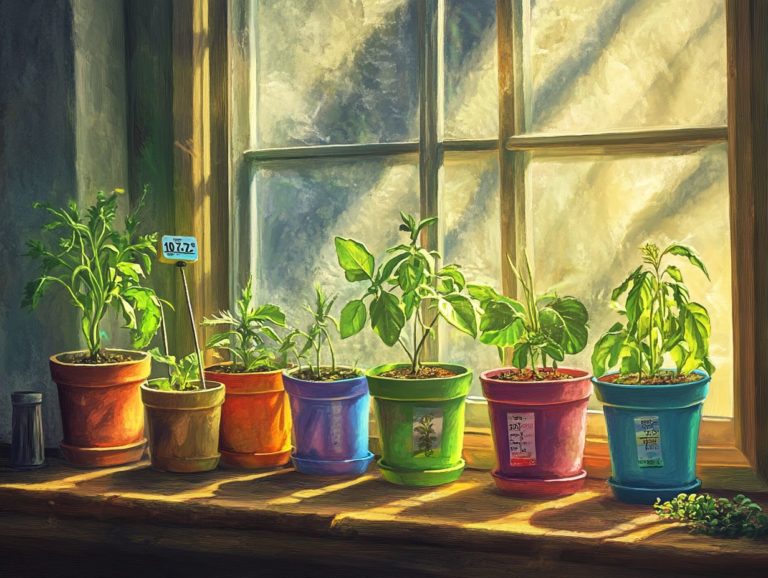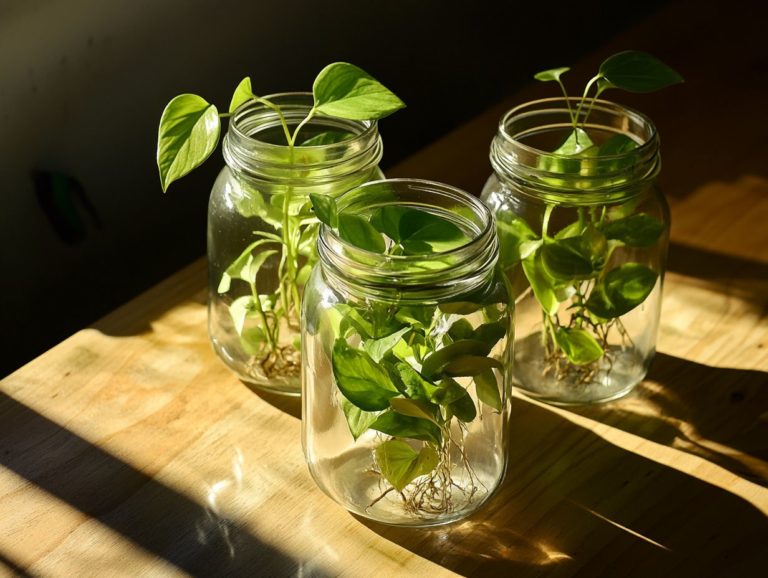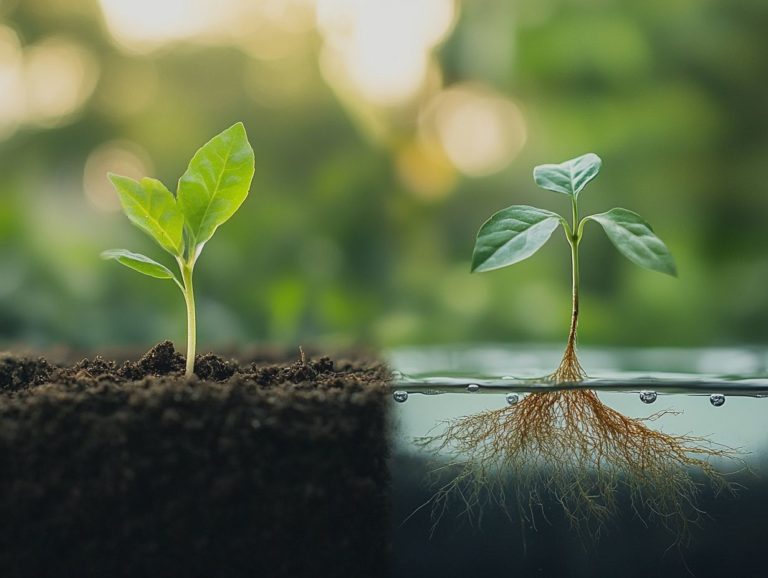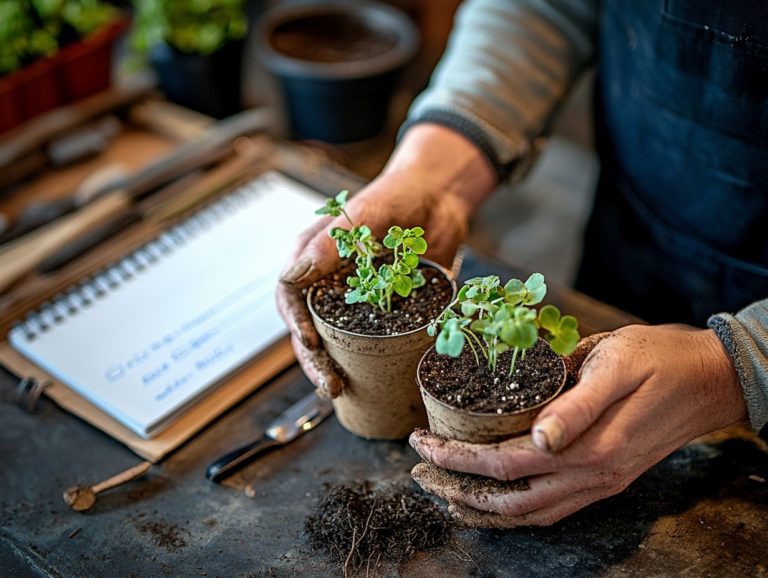How to Monitor Moisture Levels in Cuttings
Moisture levels are crucial for the health and growth of your plants. They affect everything from root development to overall vitality.
Grasping how to monitor and maintain optimal moisture is essential for anyone who gardens or nurtures plants. Let s unlock the secrets to thriving plants together!
This article delves into the effects of moisture on plant growth, effective monitoring techniques, and many factors that influence moisture levels in your cuttings.
We ll illuminate common pitfalls to steer clear of, ensuring your plants not only survive but thrive.
Contents
Key Takeaways:
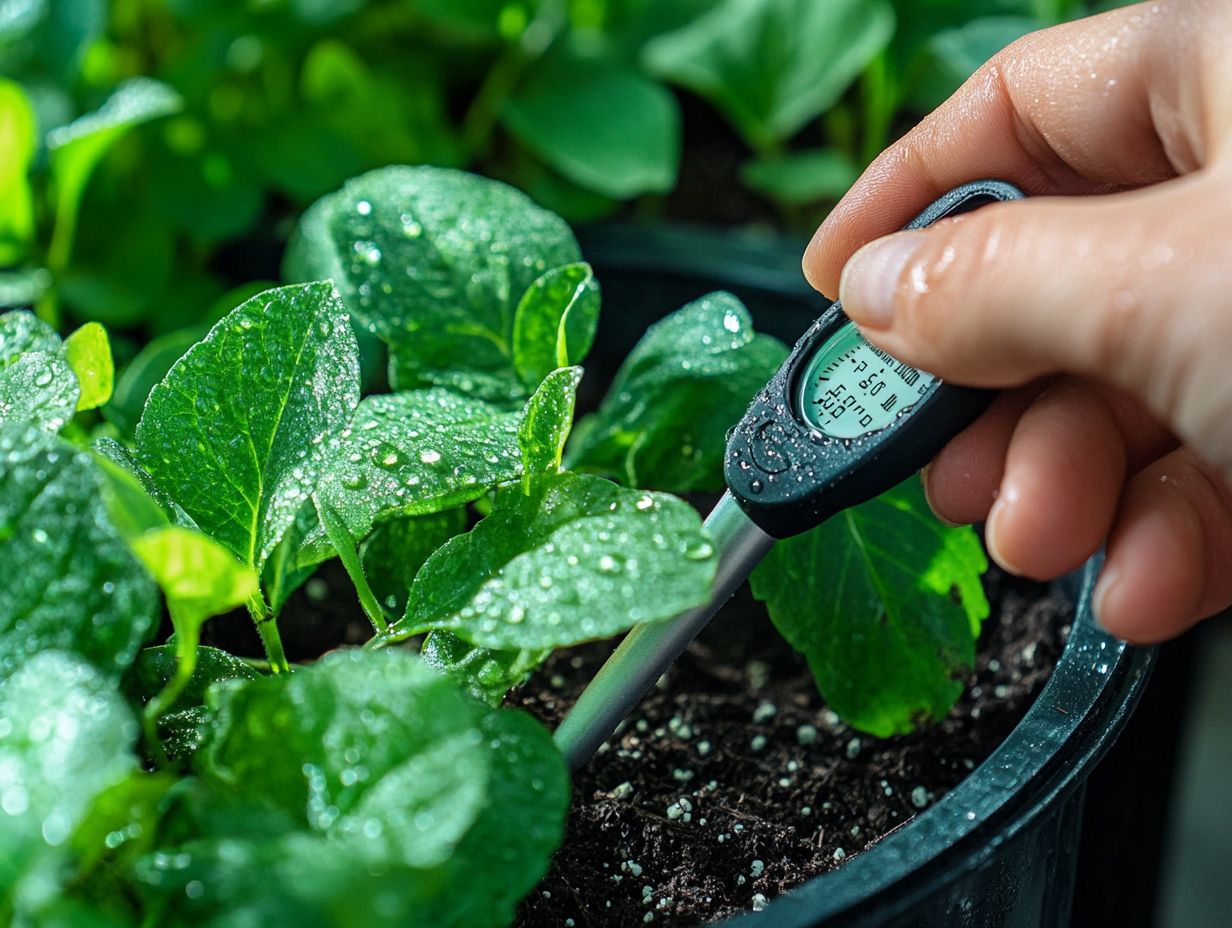
- Maintain consistent moisture for vibrant plant health.
- Use soil moisture meters and visual checks for accurate monitoring.
- Adjust care based on your plant’s unique needs.
Understanding the Importance of Moisture Levels in Cuttings
Grasping the significance of moisture levels in cuttings is essential for any plant parent keen on nurturing thriving indoor plants.
Proper moisture content is pivotal for fostering healthy growth, alleviating stress, and sidestepping challenges like overwatering and underwatering.
By employing tools such as a soil moisture meter (a tool that tells you how wet the soil is), you can accurately assess the soil s moisture levels. This allows for more effective water management and better results with various houseplants, including succulents and Snake plants.
A solid understanding of moisture levels helps you create optimal conditions for different plant species.
Effects of Moisture on Plant Growth
Moisture levels play a pivotal role in plant growth, directly impacting soil moisture content and determining whether your houseplants thrive or suffer from stress.
Proper hydration is essential for your indoor plants. Varying moisture levels can lead to a spectrum of outcomes. Overwatering can choke roots and invite root rot, especially in moisture-sensitive plants like succulents and cacti.
On the flip side, insufficient moisture can stunt growth and lead to wilting, particularly in species such as ferns and peace lilies that flourish in consistently damp soil.
Grasping the moisture requirements of your specific plants is crucial. Tropical plants typically crave higher humidity, while desert varieties are more forgiving of dry conditions.
By maintaining balanced moisture levels, you set the stage for optimal health and vibrant growth in your optimal environment.
Methods for Monitoring Moisture Levels
Monitoring moisture levels is essential for providing exceptional care to your indoor plants, including the magnificent Bird of Paradise and ZZ plants. You can employ various methods to maintain optimal conditions.
Utilizing tools like soil moisture meters offers precise readings, allowing you to gauge the soil’s condition accurately. Regular visual inspections also add value to your monitoring routine.
By understanding the appropriate testing frequency and incorporating these methods into your irrigation management strategy, you can effectively prevent the pitfalls of overwatering and underwatering, ensuring your plants thrive and flourish beautifully.
Visual Inspection
Visual inspection helps you monitor moisture levels in your houseplants, allowing you to assess their health and specific needs.
By examining the leaves, stems, and soil consistency, you can spot early signs of moisture stress, such as drooping leaves or a wilting appearance.
Discoloration or browning tips often signal that your plant is either overwatered or underwatered, highlighting the delicate balance required in plant care. Learning to recognize these symptoms is vital for promoting optimal growth and ensuring your plants receive the right amount of hydration.
Incorporating moisture monitoring techniques, like using a moisture meter, takes your natural observation method to the next level, providing you with a more accurate understanding of each plant’s water needs. To learn more about this, check out how to use moisture meters for plants.
Using Moisture Meters
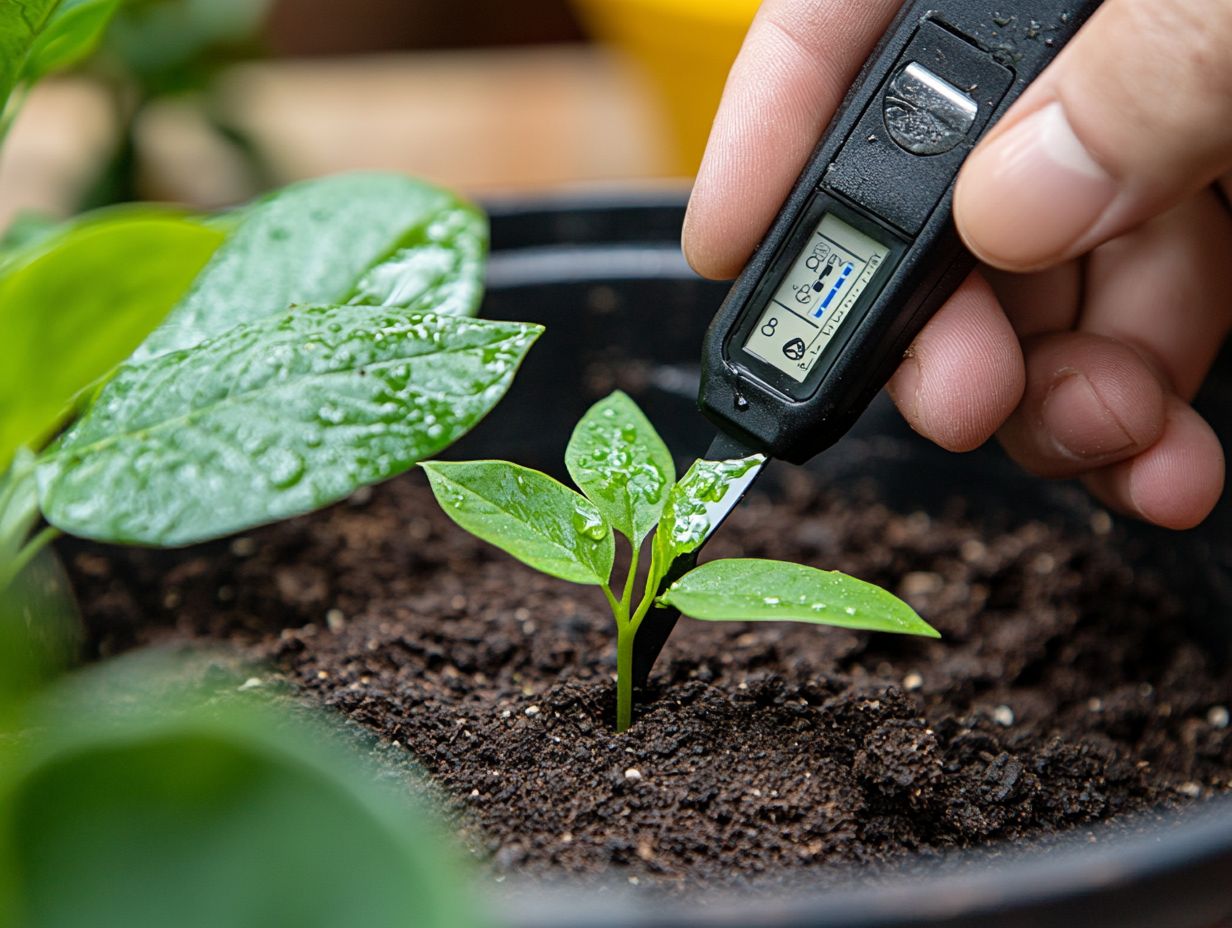
Using a soil moisture meter is one of the most effective ways to accurately assess moisture levels in your indoor plants. It’s an invaluable tool for any dedicated plant parent!
By gauging the soil’s moisture content, you can better understand when your plants truly need watering. This helps you avoid the pitfalls of both overwatering and underwatering. These meters have clear displays that give you quick results, enabling you to make fast and informed adjustments to your care routines.
When interpreting the readings, consider the specific needs of your various plant species, as their moisture requirements can vary widely. Incorporating this tool into your overall irrigation management strategy fosters healthier plant growth and promotes more efficient use of water resources, benefiting both the environment and your gardening endeavors.
Factors Affecting Moisture Levels in Cuttings
Several factors influence moisture levels in your cuttings. Environmental conditions and plant species are key players in determining the moisture needs of your indoor plants, whether they re succulents or moisture-loving varieties.
Elements like temperature, humidity, and light exposure directly affect the soil’s moisture content. Different plant species have their own unique requirements that are essential for optimal growth.
Understanding these variables is crucial for keeping your cuttings healthy and avoiding issues like root-bound plants, which occur when a plant’s roots fill up the pot and can’t absorb water properly.
Environmental Conditions
Environmental conditions such as humidity, temperature, and light exposure are pivotal in determining moisture levels in your indoor plants. These elements significantly influence how water is retained or evaporated from the soil, ultimately impacting your plants’ health.
For example, high humidity can slow down evaporation, keeping the soil moist for longer periods. This condition is ideal for certain plant species that thrive in humidity. Conversely, elevated temperatures and bright light can speed up evaporation rates, causing the soil to dry out more quickly. Regularly checking your environment is crucial for your plants’ happiness!
By adjusting factors like room temperature or using a humidifier, you can dramatically improve moisture retention and create an optimal growing environment for your beloved plants.
Plant Species
Plant species greatly influence moisture requirements. Some plants thrive on humidity while others prefer to dry out, which directly impacts your care routine.
Take the Snake plant, for example. It thrives on minimal watering, favoring drier soil conditions that mirror its native arid environment. This makes it a fantastic choice if you occasionally forget to water your plants. On the other hand, the Bird of Paradise demands consistently moist soil to truly flourish, reflecting its tropical origins where humidity is abundant.
By understanding these nuances, you can craft optimal care routines tailored to each species. This awareness ensures that your moisture-loving plants receive the hydration they crave while drought-resistant varieties avoid overwatering, ultimately fostering healthier growth in your home.
Maintaining Optimal Moisture Levels
Maintaining optimal moisture levels is vital for the health of your indoor plants. Implementing effective water management strategies is key to this endeavor.
By using proper watering techniques and incorporating materials such as mulch, you can significantly enhance the soil’s ability to retain moisture. Understanding each plant’s unique needs helps you tailor your watering approach, reducing risks associated with both overwatering and underwatering.
This thoughtful care ultimately fosters vibrant, healthy growth in your diverse collection of houseplants. Get your moisture meter today and watch your plants thrive!
Watering Techniques
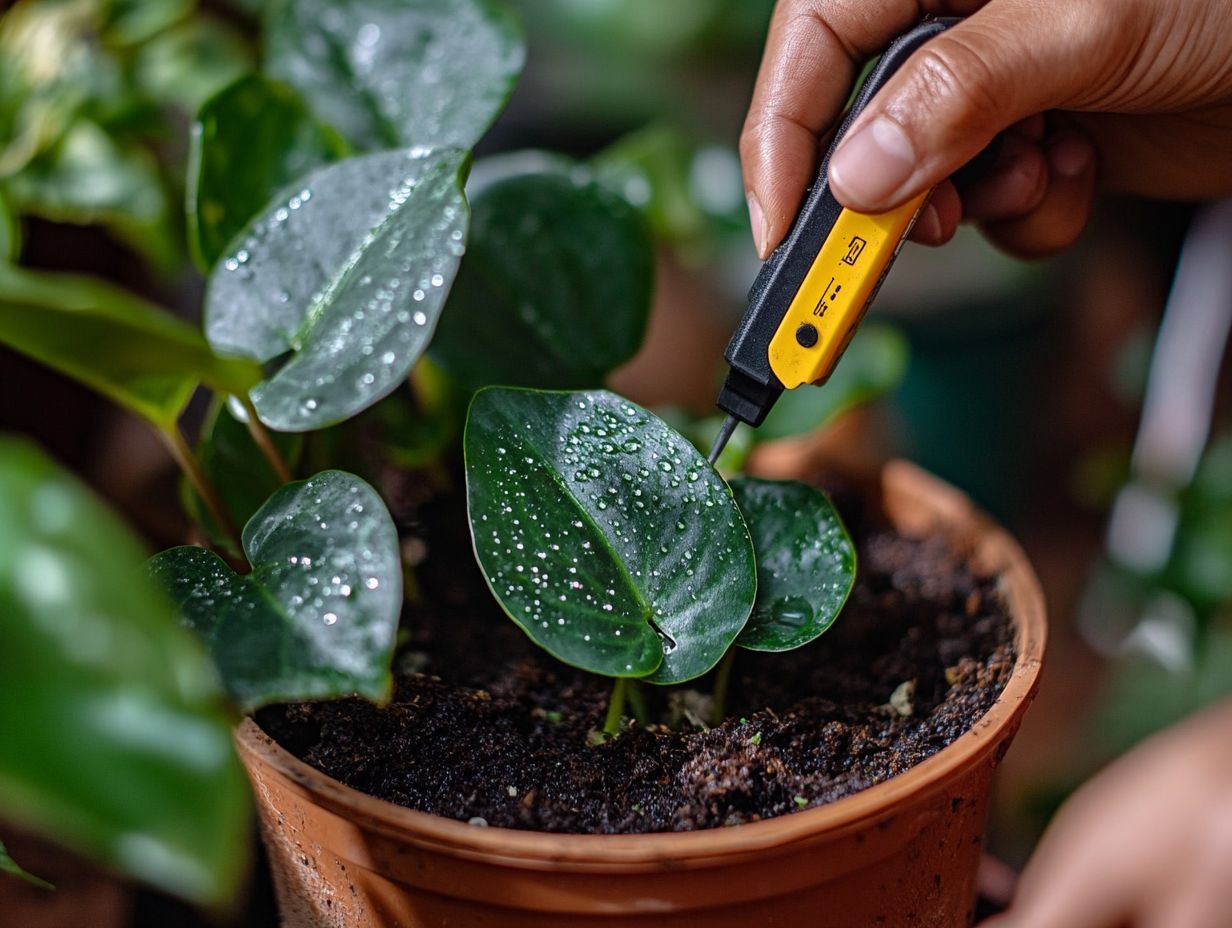
Effective watering techniques are essential for maintaining the right moisture levels in the soil. They ensure that your indoor plants flourish without the risks of overwatering or underwatering.
Consider the impact of various watering methods, such as drip irrigation (a method where water drips slowly to the roots of plants), soaking pots, or self-watering containers. Each can significantly influence the health of different plant species. Timing is just as crucial. Many plants thrive when watered in the early morning or late afternoon, which minimizes evaporation loss.
By adjusting your techniques based on environmental factors like humidity and temperature, you can cater to the specific needs of each plant. This promotes robust growth and resilience. A tailored approach boosts plant vitality and fosters a sustainable watering routine that conserves precious resources.
Using Mulch
Using mulch is an incredibly effective strategy for enhancing moisture retention in your soil. It benefits your indoor plants by preventing moisture loss and maintaining stable moisture levels. This straightforward practice can significantly elevate the health and growth of your plants.
Various types of mulch are available. Organic options like shredded bark, straw, or leaves not only conserve moisture but also enrich the soil as they decompose. Conversely, inorganic choices such as gravel or rubber provide excellent moisture retention without breaking down, offering a long-lasting solution.
By acting as a protective barrier, mulch minimizes evaporation from the soil surface. This allows your plants to thrive even in fluctuating humidity. Ultimately, incorporating mulch into your plant care routine fosters a healthier environment, ensuring your indoor greenery remains vibrant and lush.
Common Mistakes in Monitoring Moisture Levels
Common mistakes in monitoring moisture levels can create significant challenges for indoor plants. This often leads to overwatering and underwatering stemming from inaccurate soil moisture meter readings.
Many plant parents struggle to use a soil moisture meter effectively. This can lead to inadequate irrigation management strategies. Recognizing these common pitfalls is essential for fostering healthy growth and minimizing stress in your beloved houseplants.
Overwatering
Overwatering is a common pitfall in plant care that can lead to serious consequences. These include root rot and diminished moisture levels in the soil.
When your plants receive more water than they can absorb, it disrupts their natural equilibrium. This makes it challenging for various species to flourish. Take succulents and cacti, for example they thrive in drier conditions and are particularly vulnerable to overwatering. Signs of distress may include yellowing leaves or mushy stems.
Tropical plants can initially tolerate a little extra moisture, but they can face issues if the problem continues. To avoid overwatering, it’s essential to:
- Regularly check the soil moisture,
- Use well-draining potting mixes,
- Ensure that your pots have proper drainage holes.
By understanding each plant’s moisture needs, you’ll cultivate a thriving environment that keeps them healthy and vibrant.
Underwatering
Underwatering is a common issue that can significantly impact the health of your indoor plants. It leads to dry soil and insufficient moisture levels.
When you don t provide adequate water, you ll likely notice stress in the foliage. This may manifest as wilting leaves or brown edges. This condition can stunt growth, making it difficult for your plants to absorb essential nutrients from the soil.
Keep an eye out for signs of underwatering, such as crispy leaf tips, drooping stems, and soil that feels rock-hard to the touch.
To remedy this situation, consider implementing a consistent irrigation management plan. Using moisture meters can help you accurately gauge soil hydration, while mulching techniques can aid in moisture retention. This paves the way for a healthier indoor environment.
Frequently Asked Questions
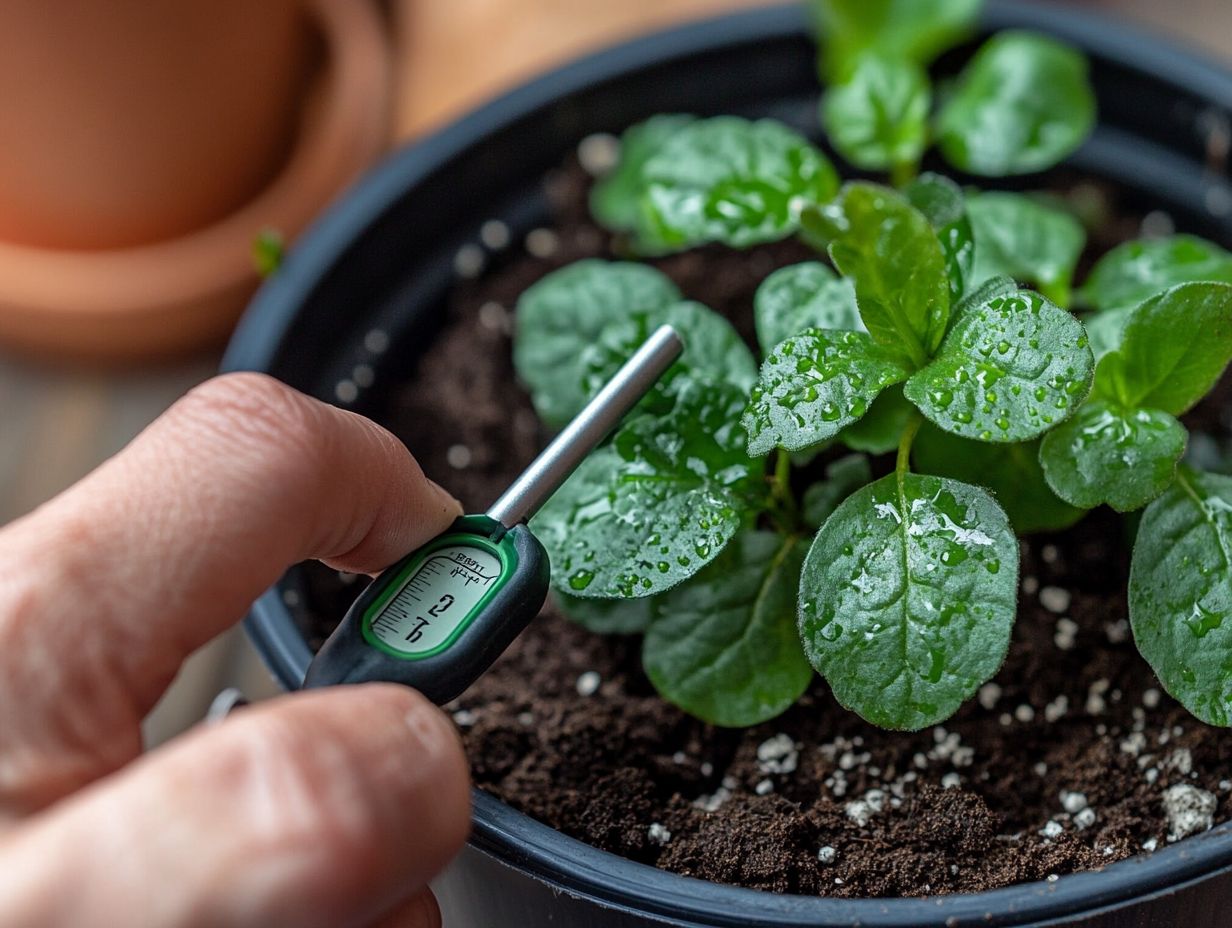
Start applying these techniques today and watch your indoor garden thrive!
What are cuttings?
Cuttings are pieces of plant stems or leaves from a parent plant. They can be propagated to grow into new plants.
Why is it important to monitor moisture levels in cuttings?
Monitoring moisture levels is critical for the growth and survival of cuttings. Too much or too little moisture can cause serious issues like root decay or mold.
How can I determine the moisture levels in cuttings?
You can use a moisture meter or simply touch the soil around the cuttings. If the soil feels dry, it s time to water the cuttings.
What is the ideal moisture level for cuttings?
The ideal moisture level for cuttings is between 50-60%. This keeps the soil moist without being soggy, which is vital for air circulation and healthy root growth.
Can I use any type of soil for my cuttings?
No, it s best to use a well-draining soil mix made for cuttings. This soil type helps prevent water from accumulating and keeps the roots healthy.
How often should I monitor the moisture levels in cuttings?
Check the moisture levels at least once a day. If it s hot and dry outside, be prepared to check more often and water as needed!



